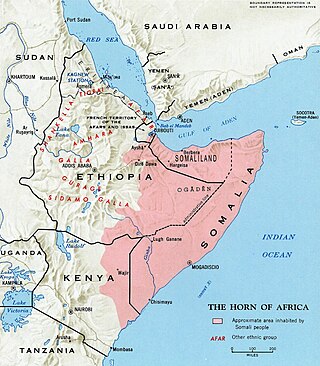
Middle Juba is an administrative region (gobol) in southern Somalia. With its capital at Bu'aale, it is located in the autonomous Jubaland region.

Somali is an Afroasiatic language belonging to the Cushitic branch. It is spoken as a mother tongue by Somalis in Greater Somalia and the Somali diaspora. Somali is an official language in Somalia and Ethiopia, and a national language in Djibouti as well as in northeastern Kenya. The Somali language is written officially with the Latin alphabet although the Arabic alphabet and several Somali scripts like Osmanya, Kaddare and the Borama script are informally used.
The Garre are a prominent Somali clan that traces its lineage back to Samaale, who is believed to have originated from the Arabian Peninsula through Aqiil Abu Talib. The Garre clan is considered to be a sub-clan of the Digil-Rahanweyn clan family, which is part of the larger Rahanweyn clan. However, genealogically, they are descended from Gardheere Samaale. The Garre are also categorized as southern Hawiye as well.

Barawa, also known as Barawe and Brava, is the capital of the South West State of Somalia. It functions as a port town in the southwestern Lower Shebelle region of Somalia. Facing the Indian Ocean, Barawa serves as the main port of the South West State.

The Rahanweyn, also known as the Digil and Mirifle are a major Somali clan. It is one of the major Somali clans in the Horn of Africa, with a large territory in the densely populated fertile valleys of the Jubba and Shebelle rivers and the areas inbetween which are mainly inhabited by settlers from the Digil and Mirifle lineages.

The endoglossic language of Somalia has always been Somali, although throughout Somalia's history various exoglossic languages have also been used at a national level.
Boon or Af-Boon is a nearly extinct Cushitic language spoken by 59 people in Jilib District, Middle Jubba Region of southern Somalia. In recent decades they have shifted to the Maay dialect of Jilib. All speakers were reported in the 1980s to be older than 60. Their traditional occupations are as hunters, leatherworkers and, more recently, shoemakers.

Mai-Mai, commonly spelled Maay Maay, is a dialect of the Somali language of the Cushitic branch of the Afro-Asiatic family. It is mainly spoken in Somalia and adjacent parts of Ethiopia and Kenya. In Somalia, it is spoken in South West state, Jubaland state, and Banadir. It is one of the dialects of the Somali language.
The Somali languages form a group that are part of the Afro-Asiatic language family. They are spoken as a mother tongue by ethnic Somalis in Horn of Africa and the Somali diaspora. Even with linguistic differences, Somalis collectively view themselves as speaking dialects of a common language.
Dabarre is a Somali language spoken by the Dabarre and Ciroole, both sub-clans of the Digil clan family of Somalis inhabiting southwestern Somalia. It has an estimated 33,000 speakers. Dialects include Dabarre and Ciroole (Af-Ciroole).
Garre is a Somali language spoken by the Garre who reside in southern Somalia, Ethiopia and northern Kenya. It belongs to the family's Cushitic branch, and had an estimated 50,000 speakers in Somalia in 1992, 57,500 in 2006 and 86,000 in 2020. The total number of speakers in Kenya and Somalia was estimated at 685,600 in 2019. Garre is in the Digil classification of Somali dialects. Garre language is readily intelligible to Digil speakers, as it has some affinity with Af-Maay and Af-Boon.
Jiiddu is an Afro-Asiatic language spoken by the Jiiddu sub-clan of the Dir, a Somali clan inhabiting southern Somalia. It is part of the family's Cushitic branch, and has an estimated 34,000 speakers mainly residing in the Lower Shabeelle, Bay and Middle Juba regions.
Benadiri Somali, also referred to as "Coastal Somali", is a dialect of the Somali language. It is primarily spoken by the Benadiri people, who inhabit the southern Banaadir coast of Somalia.
The Zigula or Zigua language, Chizigua, is a Bantu language of Tanzania and Somalia, where the Mushunguli dialect is spoken.
Northern Somali is a dialect of the Somali language and forms the basis for Standard Somali. It is spoken by more than 60% of the entire Somali population, with its speech area stretching from Djibouti, Somaliland and the Somali Region of Ethiopia This widespread modern distribution is a result of a long series of southward population movements over the past ten centuries from the Gulf of Aden littoral.
Girirra also called Gariire is a Cushitic language of Ethiopia. It has extensive borrowing from Somali. Although not mutually intelligible with Somali, it is estimated that around 70% of the Garirra language is made up of Somali loan words. There has not been many studies on the language itself and is often grouped into a small umbrella of the Macro-Somali language family including relatives like: Rendille, Boni, Bayso, and the two dialects of Somali, being Af-Maay, and Af-Maxaa.
Juba Valley Veterinary Institute or Af Somali Kuliyada Xanaanada Xoolaha ee Dooxada Juba, Arabic:, Italian: Giuba Valle Veterinario Instituto is a veterinary institute in Bardera, Gedo Somalia. The Institute is part of Bardera Polytechnic specialized schools and institutes within the college system.
The Tunni are a Somali clan that make up part of the wider Digil-Rahanweyn branch. It is one of the major clans that inhabit in the South West State of Somalia and can also be found in Jubbaland.
The Tunni Sultanate was a Somali Muslim Sultanate located in southwestern Somalia, south of the Shabelle river. It was ruled by the Tunni people, who spoke the Af-Tunni. The historical Tunni area corresponds to the modern-day Lower Shabelle region.
Kunyo Barrow is a town in the southern Middle Juba region of Somalia. Situated around 257 km northeast of the capital Mogadishu.






